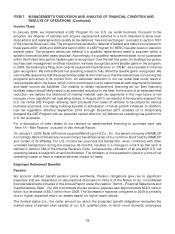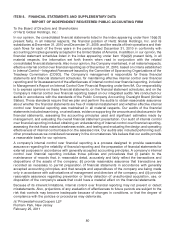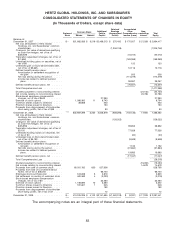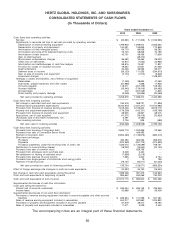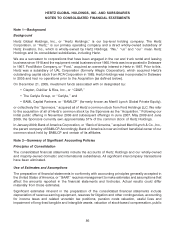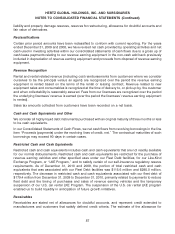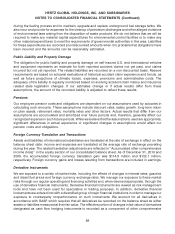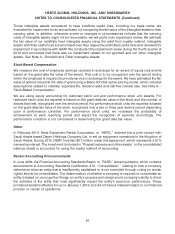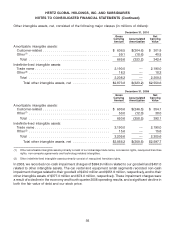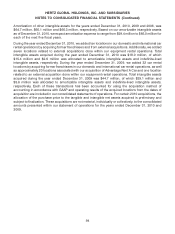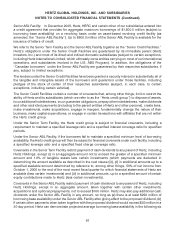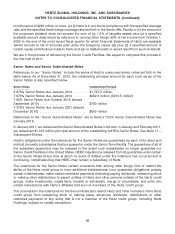Hertz 2010 Annual Report Download - page 112
Download and view the complete annual report
Please find page 112 of the 2010 Hertz annual report below. You can navigate through the pages in the report by either clicking on the pages listed below, or by using the keyword search tool below to find specific information within the annual report.HERTZ GLOBAL HOLDINGS, INC. AND SUBSIDIARIES
NOTES TO CONSOLIDATED FINANCIAL STATEMENTS (Continued)
doubtful accounts is based on our historical experience and our judgment as to the likelihood of ultimate
payment. Actual receivables are written-off against the allowance for doubtful accounts when we
determine the balance will not be collected. Bad debt expense is reflected as a component of Selling,
general and administrative in our consolidated statements of operations.
Depreciable Assets
The provisions for depreciation and amortization are computed on a straight-line basis over the
estimated useful lives of the respective assets, or in the case of revenue earning equipment over the
estimated holding period, as follows:
Revenue Earning Equipment:
Cars ........................... 4 to 26 months
Other equipment .................. 24 to 108 months
Buildings .......................... 4 to 50 years
Furniture and fixtures ................. 1 to 15 years
Capitalized internal use software ......... 1 to 15 years
Service cars and service equipment ...... 1 to 13 years
Other intangible assets ................ 3 to 15 years
Leasehold improvements .............. The shorter of their economic lives or the lease term.
We follow the practice of charging maintenance and repairs, including the cost of minor replacements, to
maintenance expense accounts. Costs of major replacements of units of property are capitalized to
property and equipment accounts and depreciated on the basis indicated above. Gains and losses on
dispositions of property and equipment are included in income as realized. When revenue earning
equipment is acquired, we estimate the period that we will hold the asset, primarily based on historical
measures of the amount of rental activity (e.g., automobile mileage and equipment usage) and the
targeted age of equipment at the time of disposal. We also estimate the residual value of the applicable
revenue earning equipment at the expected time of disposal. The residual values for rental vehicles are
affected by many factors, including make, model and options, age, physical condition, mileage, sale
location, time of the year and channel of disposition (e.g., auction, retail, dealer direct). The residual
value for rental equipment is affected by factors which include equipment age and amount of usage.
Depreciation is recorded on a straight-line basis over the estimated holding period. Depreciation rates
are reviewed on a quarterly basis based on management’s ongoing assessment of present and
estimated future market conditions, their effect on residual values at the time of disposal and the
estimated holding periods. Market conditions for used vehicle and equipment sales can also be affected
by external factors such as the economy, natural disasters, fuel prices and incentives offered by
manufacturers of new cars. These key factors are considered when estimating future residual values and
assessing depreciation rates. As a result of this ongoing assessment, we make periodic adjustments to
depreciation rates of revenue earning equipment in response to changed market conditions. Upon
disposal of revenue earning equipment, depreciation expense is adjusted for the difference between the
net proceeds received and the remaining net book value.
Environmental Liabilities
The use of automobiles and other vehicles is subject to various governmental controls designed to limit
environmental damage, including that caused by emissions and noise. Generally, these controls are met
by the manufacturer, except in the case of occasional equipment failure requiring repair by us. To comply
with environmental regulations, measures are taken at certain locations to reduce the loss of vapor
88


